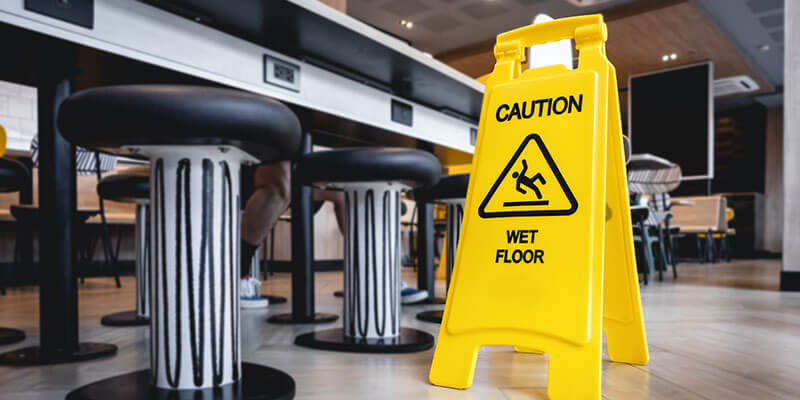Most Common Food and Beverage Business Accidents

Work in a kitchen long enough and you’ll realize the meaning of “anything that can go wrong will go wrong.”
The combination of groups of people, tight spaces, knives, moving liquids, and—who can forget—fire can often lead to a really bad day at the office, like the one that 92,600 food service workers experienced in 2018.
According to the Occupational Safety and Health Administration, for every $1 spent in safety programs, businesses can save between $4 to $6 from costs associated with injuries and fatalities. But while continuous training can certainly bring risk to a minimum at your place of business, accidents happen, and every owner should know the most common ones, the most effective way to prevent them and, if necessary, handle them properly to ensure the wellbeing of your business and staff.
Burns and Scalds
Coming in hot! Burns and scalds are quite common when you’re surrounded by burning stoves and hot fryers. Just ask Peter Brigham, former president of the Burn Foundation, a nonprofit community education and support agency, who stated that “The food service industry experiences the highest number of burns of any employment sector.”(March 15, 2017)
Be prepared for spilling and splashing hot beverages, food or even oil, to direct contact with coffee makers, fryers, pots, grills, steamers, stoves and ovens, as well as direct exposure to cleaning chemicals. Be very careful of newcomers to the food industry; they should earn the right to be left alone with all of the hot items above.
The Burn Foundation advises restaurant owners and managers to enforce the following:
- Wear protective gloves or mitts when handling hot pots or cooking with hot, deep-frying oil.
- Wear non-skid shoes to prevent slipping on wet or greasy tile floors.
- Extinguish hot oil/grease fires by sliding a lid over the top of the container.
- Never carry or move oil containers when the oil is hot or on fire.
- Make sure at least one person on each shift has first-aid training.
It’s also important to keep fire extinguishers accessible and up to date, as well as plan traffic patterns so employees carrying hot food don’t collide with each other.
Cuts, Lacerations and Punctures
You’ll want your staff to be as sharp as the knives, slicers, blenders, dishes, and glasses they handle every day, especially because these injuries are almost twice as likely to happen as suffering burns or scalds.
Peeling, slicing, mincing, dicing, and chopping can lead to serious lacerations that would leave your business short-handed (no pun intended) and stuck with steep medical bills.
Here are a few safety reminders that you may want to share with your staff.
- Avoid talking to coworkers. Talking with someone while using a knife or other cutting tool is distracting and can result in a cut finger.
- Do not crush garbage bags. Sharp objects inside the bag will poke through and cause injury.
- Use a pusher block or the automatic slicing feature on commercial slicers to keep the operator’s fingers away from the spinning blade.
- Never use a glass to scoop ice. The glass can break and cause cuts and will contaminate the entire bin of ice.
Slips, Trips, and Falls
Not everyone is born with cat-like reflexes, that’s why we’d like to help you prevent these common accidents by taking essential measures.
Theses are a few reminders on how to avoid slips, trips and falls:
- Require all employees to wear sturdy shoes with slip-resistant soles and low heels.
- An entrance mat can be an important first line of defense against slips by removing moisture from footwear. Place it on a clean, dry surface.
- Keep a stepladder in the storage area to help employees safely reach high items. Never place a ladder on top of boxes or other unstable items.
- Don’t leave a spill unattended while getting a mop. Place a “Caution: Wet Floor” sign by the spill, and keep it posted until the area is clean and dry.
- Avoid using the same mop in the front that you use in the back, to prevent spreading grease.
Sprains and Strains
Last but not least, sprains and strains are head to head with cuts and lacerations as the main cause for forced time off in the industry.
Between lifting heavy items and reaching high shelves, the chance to end up worse than you started is more likely than not. Do these activities enough times during the day, every day, and it’ll take a toll on your muscles, tendons and ligaments.
Luckily, the Society for Human Resource Management (SHRM) has your back:
- Encourage your staff to rest and recover from fatigue activities. Workers who do not get adequate rest and recovery put themselves at higher risk.
- Do some engineering controls to eliminate or reduce awkward postures so your employees can accomplish work tasks within the mid-range of motion positions for vulnerable joints.
- Listen to the early warning signs of future injuries that your staff presents in your workforce today. Early intervention is a proactive strategy designed to discover early warning signs of musculoskeletal disorders and prevent these signs from developing into an injury.
To Wrap Up
Please make sure you and your staff take proper measures against cross-contamination, food poisoning and eye injuries, all of which are less likely to happen but no less important to watch out for.
Expenses associated to injuries and illnesses include both direct costs such as medical fees, charges for legal services and compensation payments to the worker, as well as indirect costs which include training replacement employees (causing lost of productivity), accident investigation, implementation of corrective measures to avoid future accidents, and repairs of damaged items and gear.
For all of the above, you can also rely on PolicySweet® Business Owners Policy insurance and Workers’ Compensation insurance policies from food industry insurance experts. Getting a quote is as easy as 1, 2, Sweet.